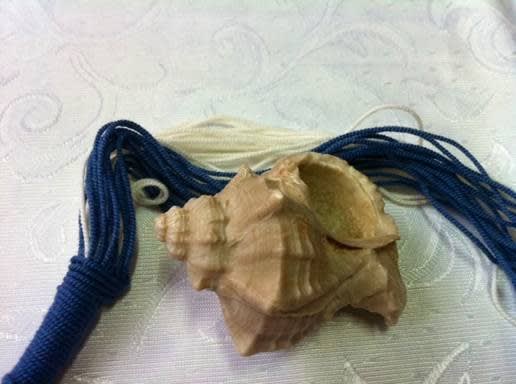
Kfar Adumim factory revives the lost commandment of tekhelet
“God said to Moses saying speak to the Children of Israel and bid them that they make fringes on the corners of their garments throughout their generations, and that they put upon the fringe (tzitzit) of each corner a thread of blue (tekhelet). And it shall be for you as a fringe, that you may look upon it and remember all the commandments of God, and do them…” (Numbers 15:37-39)
KFAR ADUMIM – Joel Guberman has a colorful story – but it’s all in hues of royal purple and brilliant blue. From a non-descript building in an industrial zone in the Judean Desert east of Jerusalem, the New Jersey-born occupational therapist is engaged in a halachic revolution – getting Jews to adopt the lost commandment of wearing of blue tzitziyot.
Guberman is an expert on tekhelet – the little understood dye referred to 48 times in the Bible that colored the tassels of Jews’ ritual prayer shawls. The first reference occurs in this week’s Torah reading Terumah (Exodus 25:4).
Long before Diaspora Jews came to specialize in the shmatta business, they had a historic connection to dyeing textiles, he explains. One of the Torah’s 613 commandments is to incorporate an azure thread among the tzitzit as a conspicuous reminder of the complete system of divine rules.
Archaeological remains of dyeing vat complexes and vast mounds of snail shells found along the Mediterranean coast from Dor south of Haifa to Tyre attest to that lucrative technology. A rare species of sea snail generated huge wealth for the ancient peoples of Judea and Phoenicia – today’s Israel and Lebanon.

Eager to control this source of revenue, the Roman Empire restricted the wearing of royal purple and tekhelet blue to aristocracy, and made the manufacture of these dyes a monopoly of imperial dye houses. The laws drove the Jewish tekhelet industry underground, just as other restrictive policies encouraged the Jews to emigrate into exile. By the time of the Arab conquest of the Land of Israel in 639 C.E. the technology had been lost. As a result, Jews began wearing plain white tzitziot.
Now that is changing, thanks to the efforts of Ptil Tekhelet (the Association for the Promotion and Distribution of Tekhelet), which Guberman co-founded in 1993 together with fellow scuba divers Dr. Ari Greenspan and Baruch Sterman – who holds a PhD in physics, and Rabbi Eliyahu Tavger.
Their non-profit amuta (foundation) is based on the research In the 1980s of Otto Elsner, a chemist at Ramat Gan’s Shenkar College of Engineering and Design, who discovered that if a solution of the purple dye made from the hypobranchial gland of the Murex trunculus snail was exposed to the sun’s ultraviolet rays, it would turn a deep shade of blue.
Popularizing that knowledge has been a slow process. According to the Talmud, tekhelet is a specific azure dye produced from a sea creature known as a chilazon. Rabbinic sages ruled that vegetable indigo dyes were unacceptable.

Over the past 150 years several marine creatures were proposed for reviving the biblical process of dyeing the tassels, among them one favored by Israel’s first chief rabbi, Isaac Herzog, father of Israel’s sixth President Chaim Herzog. He believed that the violet pelagic snail, Janthina janthina, was the source of the ritual tekhelet.
Another theory was proposed by Rabbi Gershon Hanokh Leiner, known as the Radzyner Rebbe, who produced blue dye from the black ink of the sepia officinalis (the common cuttlefish). But chemical analysis identified his dye as Prussian blue, an inorganic synthetic color derived from iron filings and not from the squid itself.
That dispute continues to reverberate till today: most of the blue-colored tzitziot worn in Israel today are dyed from the inexpensive cuttlefish, Guberman acknowledges. (The tekhelet factory in Radzyn near Lublin in Poland was destroyed during the Holocaust and the technology lost but was revived in postwar Israel thanks to the research of Rabbi Herzog.)

The rediscovery of tekhelet has almost messianic implications: one rabbinic source notes “The revelation of the hilazon is a sign that the redemption is shining near.” On a more secular level, Israel’s blue and white flag alludes to the traditional colors of the prayer shawl and tzitziot.
“One hundred percent is a big number,” Guberman says of the ever-increasing share of the Israeli public wearing blue ritual fringes produced from the Murex trunculus. “We believe it is a process how halacha gets accepted. Nowhere in the Torah does it say that the tekhelet [source] was a mollusk. But nowhere in the Torah does it say gold is a metal. It’s a given.”
Today the Ptil Tekhelet foundation is selling some 500 to 800 sets of tzitziyot monthly, both for the tallit (prayer shawl) and the arba kanfot (four-cornered) undergarment. The process requires more than a ton annually of Murex trunculus, most of which Guberman imports from Croatia, Djerba, Greece and Spain.
The fringes sell for between NIS 80 to 190 ($20 to $47.50), depending on the length and thickness of the string. They are spun on site using merino sheep wool.
“We’re the only place in the world doing this from the Murex trunculus,” Guberman notes with pride.
What of the future?
Ptil Tekhelet has consulted with Israeli marine biologists and is looking for an investor in order to establish a snail growing facility at either Mikhmoret or Eilat. When that happens Israel will have a new if non-kosher export delicacy – escargot de mer.
Gil Zohar is a Jerusalem-based journalist.
The words of this author reflect his/her own opinions and do not necessarily represent the official position of the Orthodox Union.



